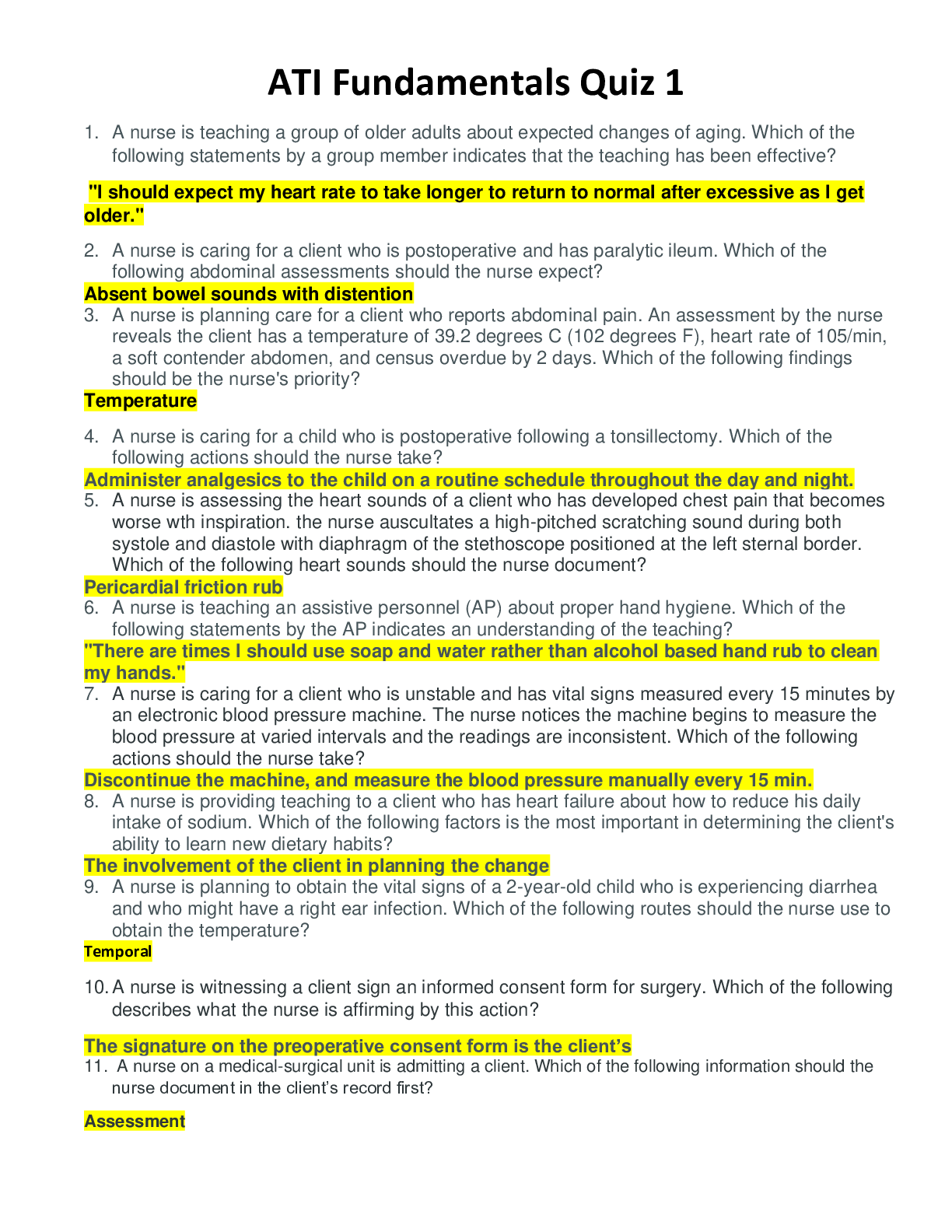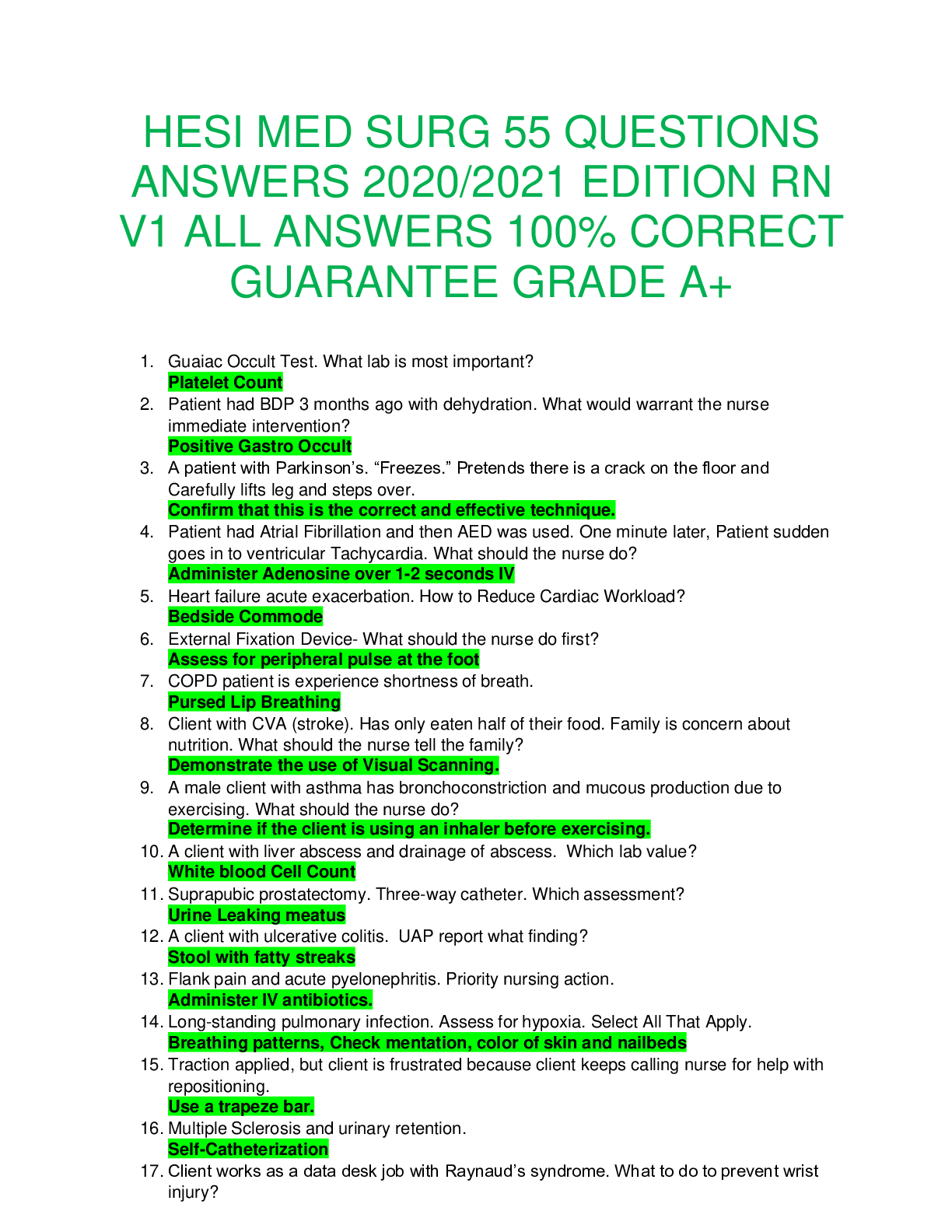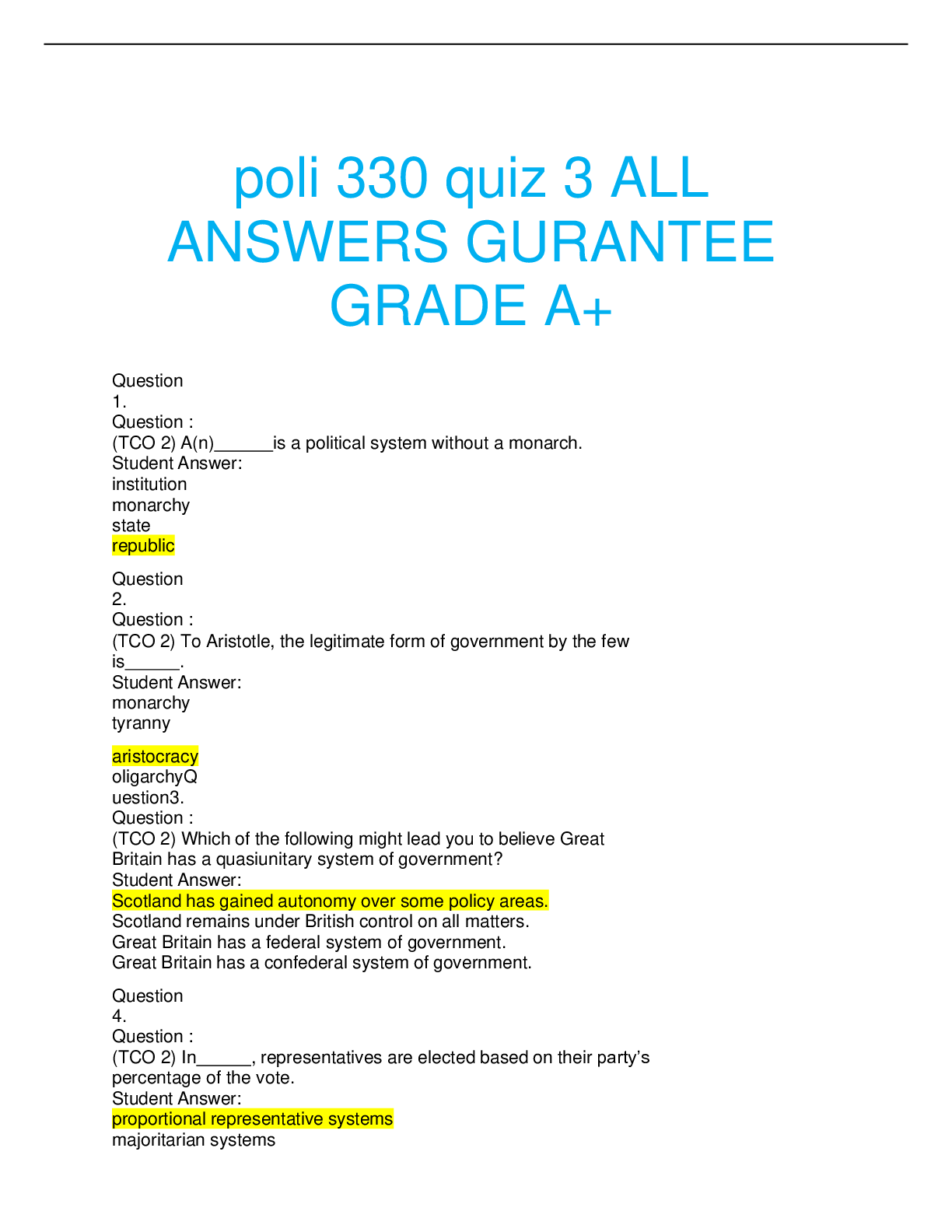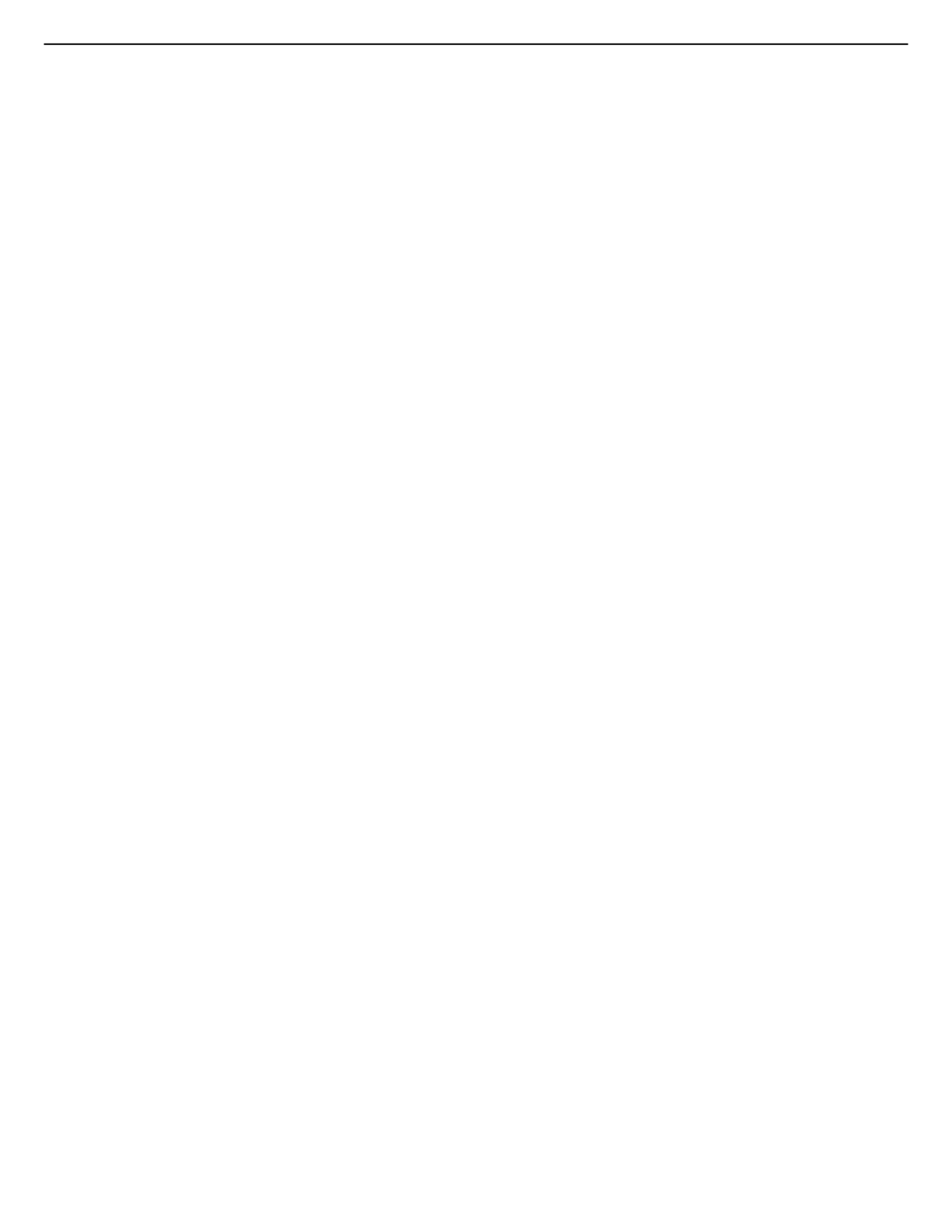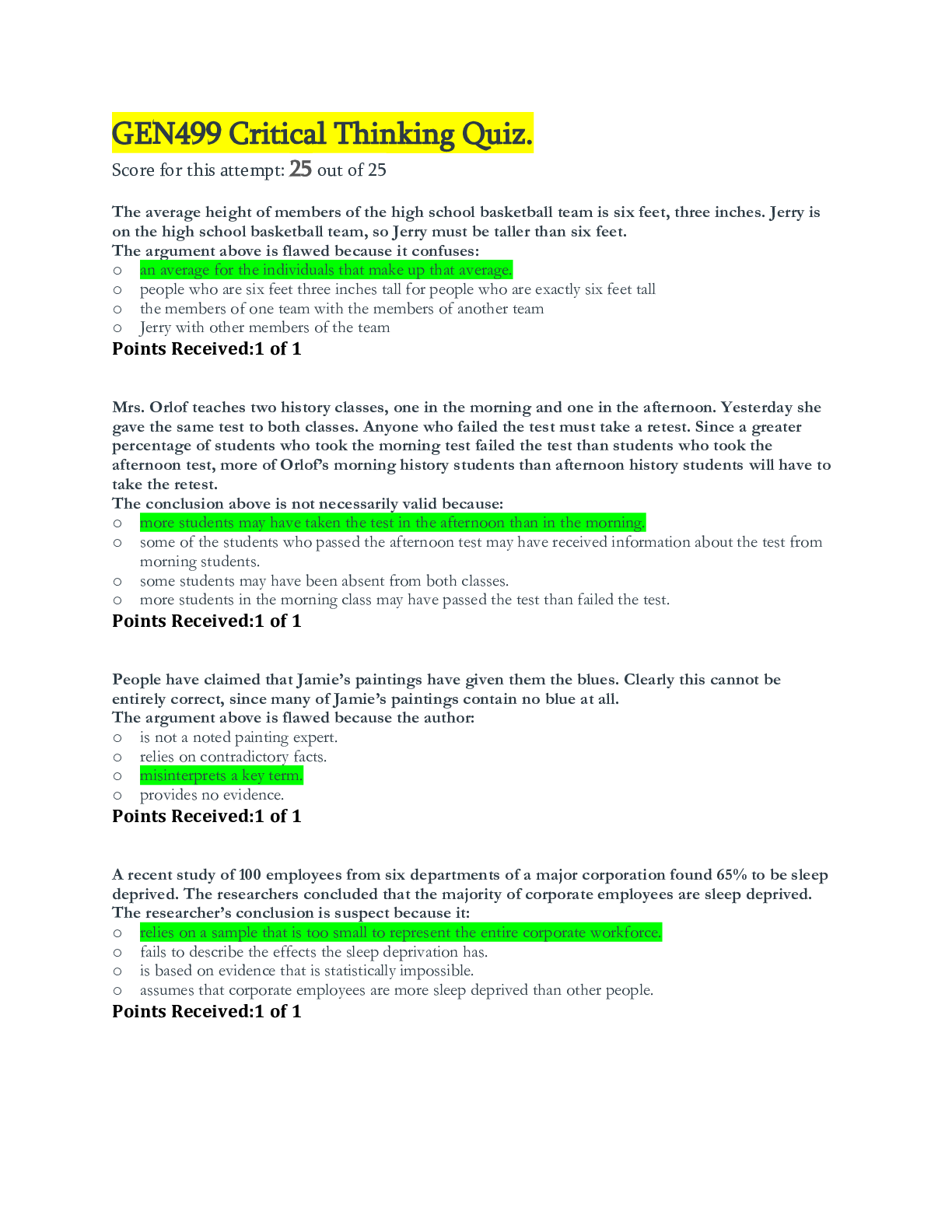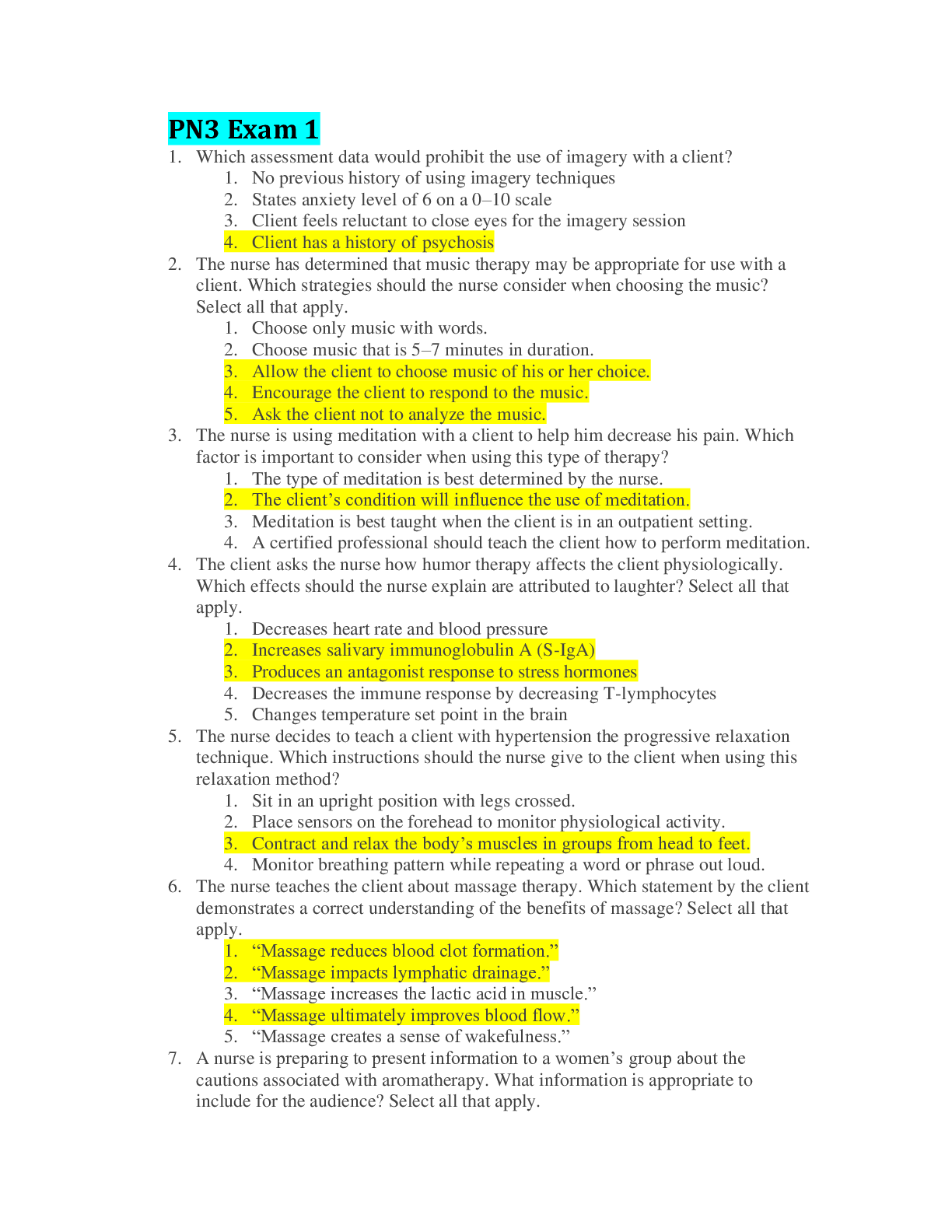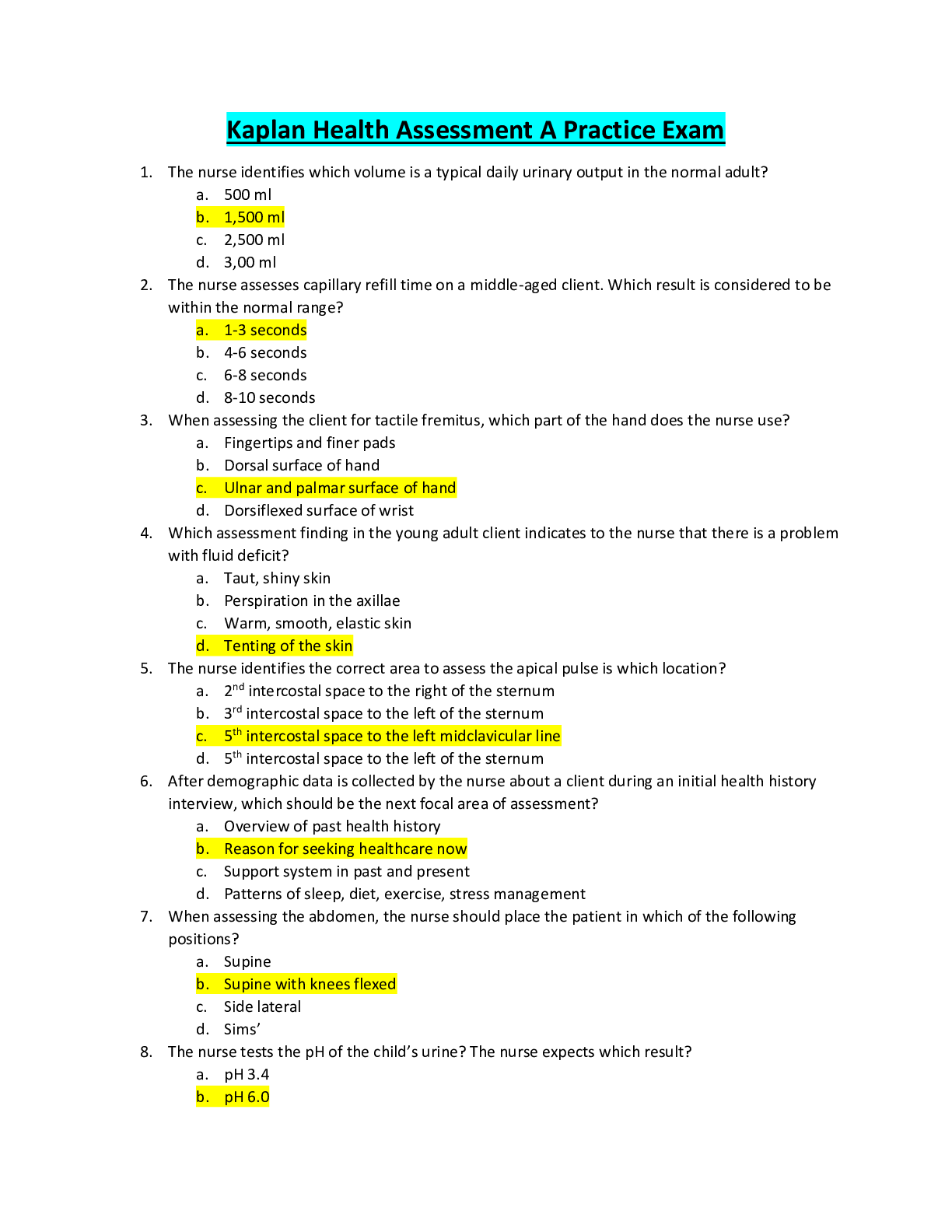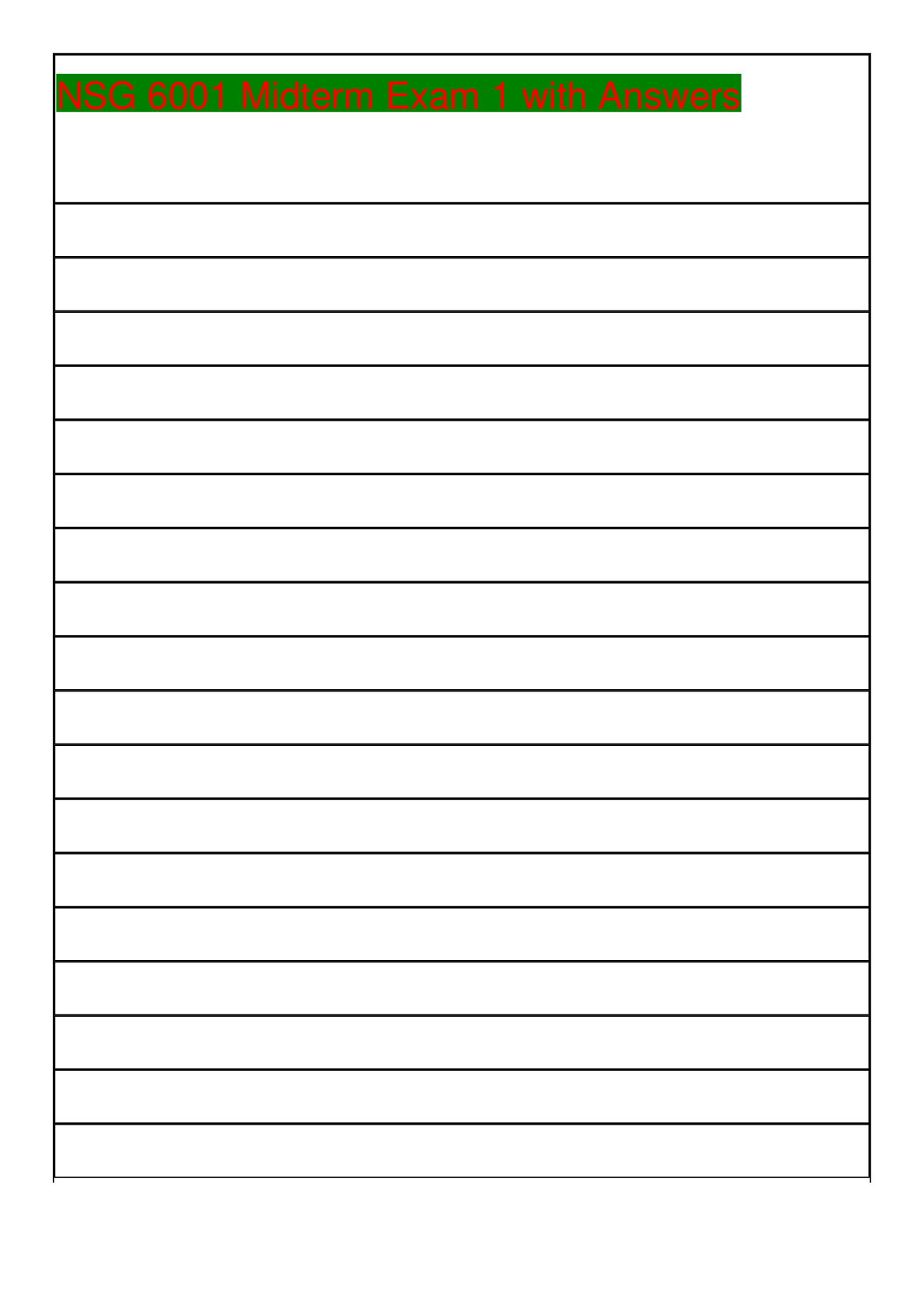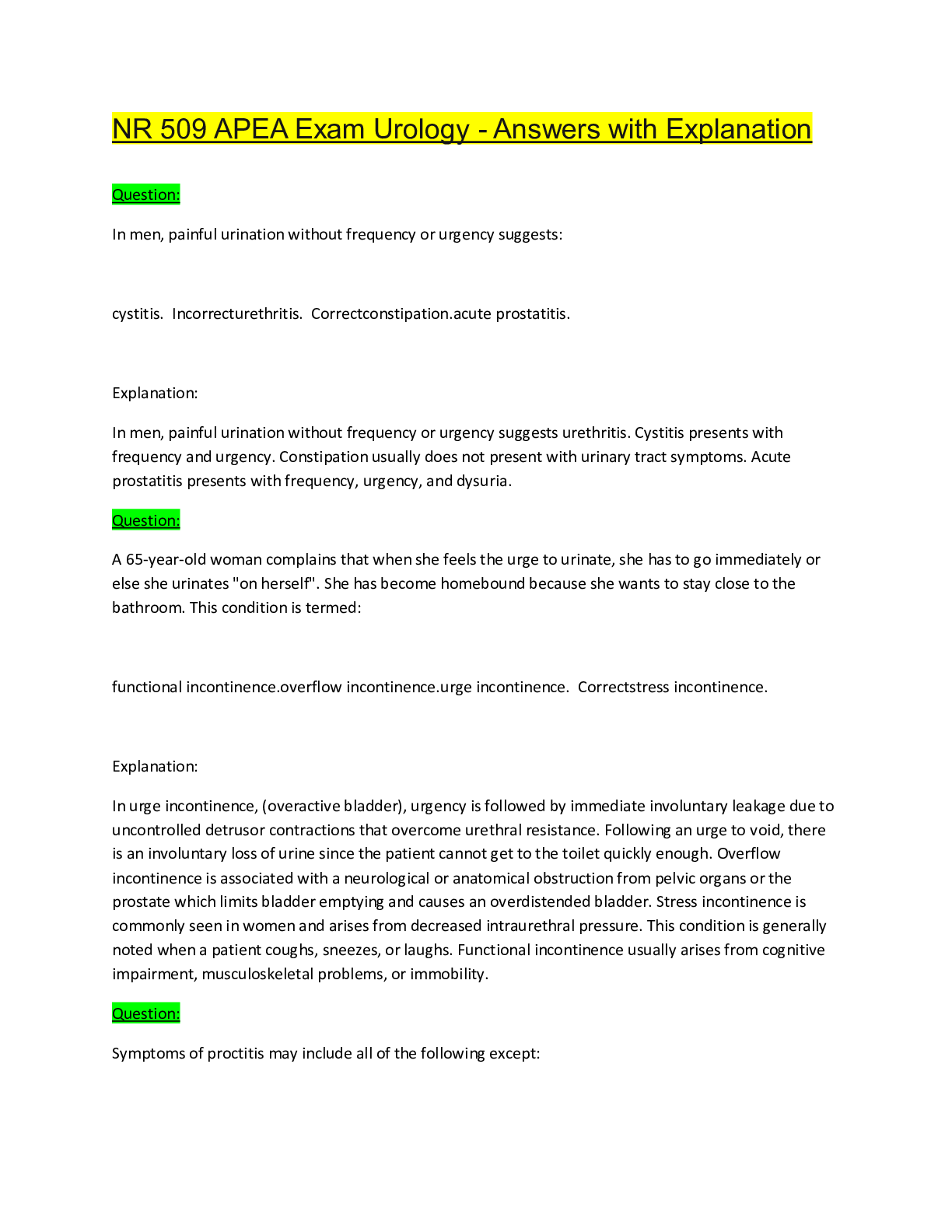Health Care > QUESTIONS & ANSWERS > EVIDENCE BASED PRACTICE FOR NURSES 3RD EDITION SCHMIDT TEST BANK/ Test bank for Schmidt & Brown 3rd (All)
EVIDENCE BASED PRACTICE FOR NURSES 3RD EDITION SCHMIDT TEST BANK/ Test bank for Schmidt & Brown 3rd Edition Evidence-Based Practice for Nurses ALL ANSWERS 100% CORRECT GUARANTEED GRADE A+
Document Content and Description Below
1. Which of the following is the best definition of research? a. Critically thinking about problems that occur in health care to determine possible solutions. b. Information that is based on persona... l experience or tradition. c. Planned and systematic activity that leads to new knowledge and/or the discovery of solutions to problems or questions. d. Trying a variety of approaches to a clinical problem and settling on the approach that is effective more often than not. Definition of research utilization (p. 4) 2. Which of the following is the best definition of research utilization? a. Applying research findings from individual studies to practice. b. Analyzing multiple research studies to synthesize findings. c. Appreciating the importance of clinical decision making. d. Using previous personal experience to build confidence. Definition of EBP (pp. 4-5) 3. Which of the following is the best definition of evidence-based practice (EBP)? a. Application of research findings based on scientific theories in a clinical setting. b. Research studies that correspond to nationally established priorities for healthcare, conducted by experts in their fields. c. Use of theory-derived, research-based information in making decisions about health care delivery, with consideration of individual needs and preferences and the clinical expertise of the provider. d. Using the individual health care provider’s perception of truth without conscious attention or reasoning. Difference between research utilization and EBP (pp. 4-5) 4. Which of the following best describes the difference between research utilization and EBP? a. Research utilization is a process of evaluating multiple studies for the most generalizable findings; EBP is use of the most recent study on a topic. b. Research utilization involves changing practice based on findings of a single research study; EBP is the syntheses of findings from multiple studies to incorporate with practitioner skills and client preference to determine best care. c. Research utilization is the application of research findings to health care practice; EBP is considered in selecting medication options. d. Research utilization is review of research publications; EBP is using the healthcare provider’s perception of what care would be best in individual situations. Evidence from other disciplines (p. 6) 5. In what way can evidence from disciplines other than nursing be helpful? a. Theory based non-nursing evidence can provide a basis on which to build new evidence. b. Non-nursing evidence supports the use of nursing knowledge obtained by trial and error. c. Clinical decision making can be based on findings from single non-nursing research studies. d. All evidence is equally important to the practice of nursing. Identification of sources of evidence (p. 6) 6. You are a new nurse working at XYZ hospital. Your preceptor tells you to dangle Ms. Jones’ legs on the side of the bed before you attempt to assist her to a chair. You ask your preceptor why this is done and she answers, “This is what we have always done, so go do it.” This is an example of which type of evidence? a. Trial and error b. Intuition c. Borrowed evidence d. Tradition Identification of sources of evidence (p. 6) 7. You are a new nurse working at XYZ hospital. Your preceptor tells you to dangle Ms. Jones’ legs on the side of the bed before you attempt to assist her to a chair. You ask your preceptor why this is done and she answers, “Because I said so.” This is an example of which type of evidence? a. Intuition b. Tradition c. Authority d. Borrowed evidence Identification of sources of evidence (p. 6) 8. Trial and error is not a preferred approach for delivering nursing care because a. it is not based on systematic scientific approaches. b. it is not a sanctioned method by the American Nurses Association. c. it is based only on intuition and therefore not scientifically based. d. patient outcomes are always based only on level 1 evidence. Identification of sources of evidence (p. 8) 9. Many nurses in clinical settings base nursing interventions on information obtained from a. level 1 evidence. b. individual research studies. c. colleagues. d. the American Nurses Association. Barriers to adopting EBP (p. 8) 10. Studies have shown that the reasons that nurses do not draw on research are related to a. communication problems. b. individual and organizational factors. c. personal disinterest. d. rapid organizational changes. Environment for EBP to flourish (p. 11) 11. Which of the following promotes consistent EBP practice changes in an institution? a. Clinical experts such as Advanced Practice Nurses (APNs) should be the authority for any change in practices. b. Change champions are needed on each work shift to facilitate practice changes. c. Nurse managers must mandate research within healthcare institutions. d. Opinion leaders should enforce adherence to their opinions. Environment for EBP to flourish (p. 10) 12. One method for overcoming a lack of resources to access evidence is to a. devote 15 minutes a day to reading evidence related to a clinical problem. b. attend conferences where clinical research is presented.. c. bookmark important Web sites that are sources of clinical guidelines. d. collaborate with a nursing program for access to resources. Barriers to adopting EBP (p. 9) 13. What steps can be taken to overcome the time barrier to adopting an EBP? a. Devote 15 minutes a day to reading evidence related to a clinical problem. b. Subscribe to e-mail summaries of research studies in your area of interest. c. Take advantage of available technologies to provide quick and convenient access to relevant data and clinical guidelines. d. All of the above Parts of a research article (p. 18) 14. Which section of a research article provides an overview of the study? a. Abstract b. Introduction c. Review of literature d. Theoretical framework Parts of a research article (pp. 18) 15. Which section of a research article identifies the problem being studied and includes a purpose statement and background information on the topic? a. Discussion section b. Introduction c. Methods section d. Results section Parts of a research article (p. 19) 16. A major portion of a research article is the methods section, which includes a discussion of the study design, the sample, and the collected. a. solutions b. statistics c. data d. theories Parts of a research article (p. 19) 17. The section of a research article outlines the methods used to analyze the data and notes the findings. a. results b. summary c. introduction d. abstract Parts of a research article (p. 20) 18. Which section of a research article provides an interpretation of the study’s results? a. Abstract b. Introduction c. Methods d. Discussion Ethical issues (p. 24) 19. The first regulations to protect human subjects in medical research studies were proposed by the in 1973. a. American Medical Association b. U.S. Department of Health, Education, and Welfare c. U.S. Food and Drug Administration d. Association of American Universities Ethical issues (p. 31) 20. Which of the following forms the basis for ethical conduct in medical research internationally? a. Jewish Chronic Disease Hospital study b. Nuremberg Code c. Tuskegee studies d. Willowbrook studies Short Answer/Fill-in Identifying types of research 1. The category of research that addresses why or how phenomena are related is . Answer: explanatory (p. 15) 2. research aims to forecast when certain phenomena will occur. Answer: predictive (p. 15) 3. The type of research that analyzes words to focus on the meanings individuals give to their experiences is . Answer: qualitative (p. 17) 4. Quantitative research focuses on collecting evidence, which is evidence gathered through observation using one or more of the five senses. Answer: empirical (p. 15) 5. research is concerned with providing accurate observations of phenomena in natural settings Answer: descriptive (p. 15) CHAPTER TWO USING EVIDENCE THROUGH COLLABORATION TO PROMOTE EXCELLENCE IN NURSING PRACTICE Multiple choice EBP levels of collaboration (p. 40) 1. What are the five EBP levels of collaboration? a. Organizational, societal, fraternal, national, and international b. Individual, organizational, regional, national, and international c. Professional, educational, organizational, regional, and national d. Individual, organizational, societal, regional, and international EBP levels of collaboration (p. 40) 2. Of the situations listed, which is the best example of collaboration between the levels described in the model of EBP collaboration? a. A health care organization funds a group of nurses to attend a research conference related to practice areas that have had less than desirable outcomes in the past year. b. An individual nurse searches databases for the best evidence to support practice with a population of clients on a particular unit. c. A participant at a national nursing organization conference listens attentively to presenters related to the most relevant topics for the population served. d. A staff nurse uses findings from the Joanna Briggs Institute to support an EBP project, evaluates outcomes, and reports the findings at an international conference. Individual nurse level (pp. 40-41) 3. What is one step a staff nurse can take to advance EBP at the point of care? a. Establish the culture for EBP in institutional settings. b. Identify clinical questions related to current nursing practice. c. Promote consistent practice changes among different shifts. d. Reward nurses involved in EBP and help those who lack involvement. Individual nurse level (p. 41) 4. As a staff nurse, what steps can you take to advance EBP as part of your team or unit? a. Participate in implementing practice changes based on evidence. b. Participate as a member of an EBP project team. c. Participate in QI initiatives d. All of the above. Individual nurse level (p. 41) 5. As a staff nurse, how can you further educate yourself about EBP? a. Read evidence related to your area of practice on a regular basis. b. Watch what other nurses do. c. Follow the example of your supervisor. d. Act as a role model for younger staff. Nurse manager level (p. 41) 6. How can a nurse manager advance EBP as part of evaluating his or her staff? a. Set a good example with own behavior. b. Clearly outline goals for the team. c. Use performance criteria related to EBP. d. Participate in QI initiatives. Advanced practice nurse level (p. 41) 7. The advanced practice nurse can work to implement EBP by a. Serving as a coach and mentor in EBP. b. Locates relevant evidence and synthesizes evidence for practice. c. Uses evidence to writes and modify practice standards. d. All of the above. Organizational level (p. 43) 8. Creating an EBP culture is an example of contribution at the a. organizational level. b. individual nurse level. c. regional level. d. international level. International level (p. 48) 9. The Cochrane Collaboration and the Joanna Briggs Institute are examples of which EBP collaboration level? a. Individual b. International c. Organizational d. Regional [Show More]
Last updated: 1 year ago
Preview 1 out of 89 pages
Instant download
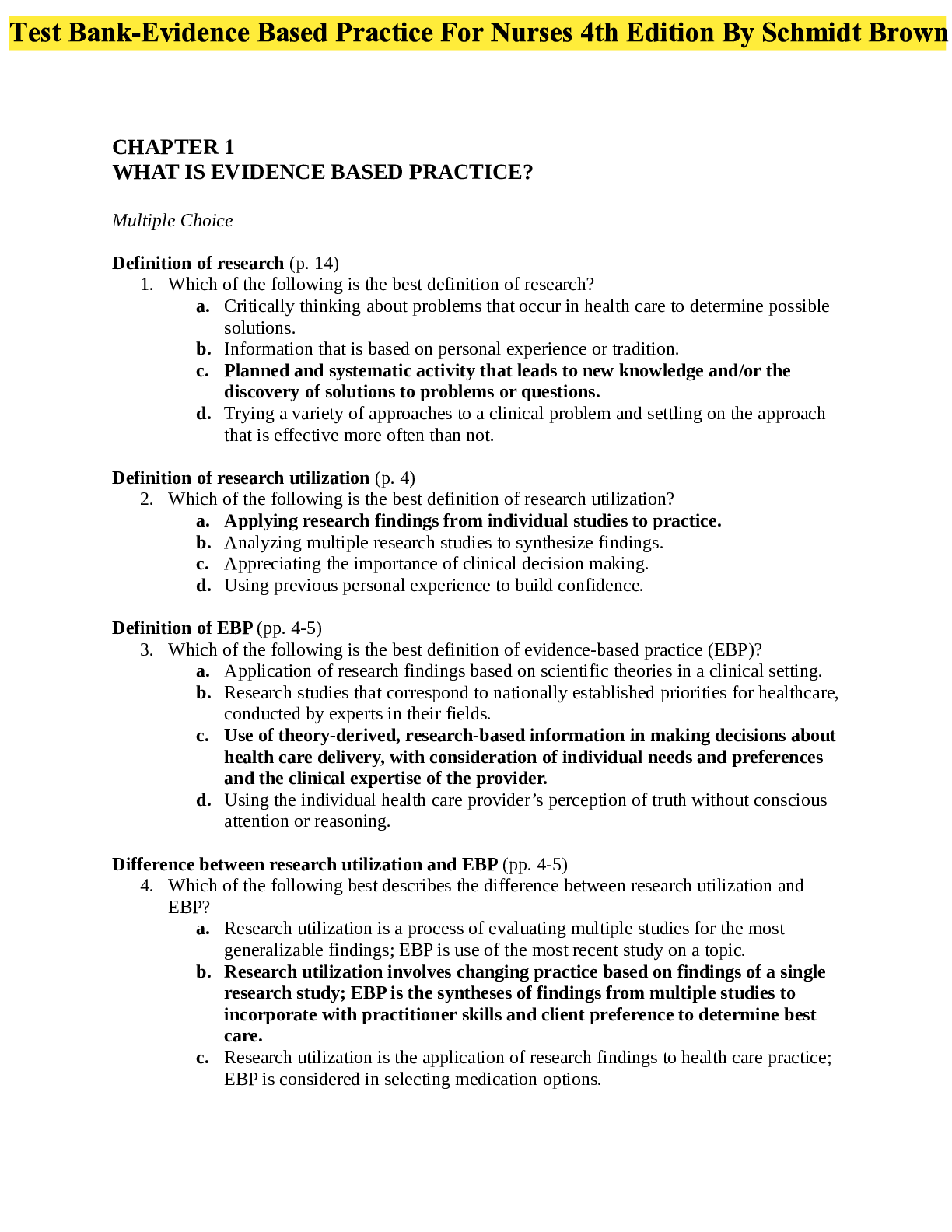
Buy this document to get the full access instantly
Instant Download Access after purchase
Add to cartInstant download
Reviews( 0 )
Document information
Connected school, study & course
About the document
Uploaded On
Oct 21, 2021
Number of pages
89
Written in
Additional information
This document has been written for:
Uploaded
Oct 21, 2021
Downloads
0
Views
51

